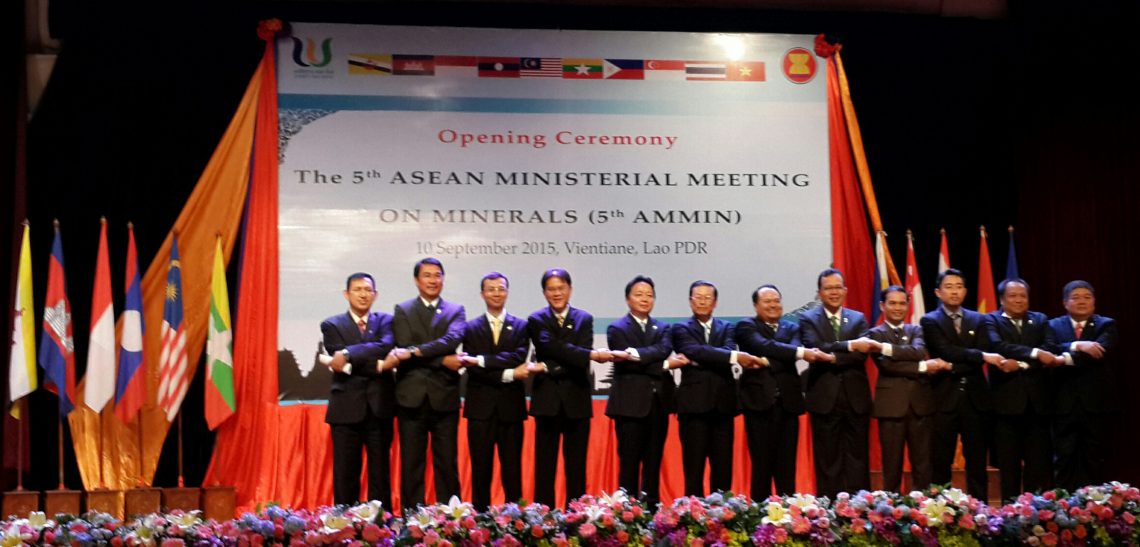1. The Fifth ASEAN Ministerial Meeting on Minerals (AMMin) was held on 10 September 2015 in Vientiane, Lao PDR. H.E. Dr. Khammany Inthirath, Minister of Energy and Mines of Lao PDR, chaired the Meeting, and Dr. Ye Myint Swe, Director General of Department of Geological Survey and Mineral Exploration of Myanmar, on behalf of H.E. Dr. Myint Aung, Minister of Mines of Myanmar, was the Vice Chair.
Opening Ceremony
2. H.E. Somsavat Lengsavad, the Deputy Prime Minister of Lao PDR officiated the 5th AMMin and associated meetings. In his Opening Remarks, H.E. Lengsavad commended the ASEAN Senior Officials on Minerals for the remarkable achievements, particularly in the implementation of the ASEAN Minerals Cooperation Action Plan (AMCAP)-II (2011-2015). He stated that ASEAN cooperation in minerals has played significant role as one of the main engines in driving economic growth and social progress in ASEAN that has contributed greatly to the improvement of livelihood, narrowing development gap within and between ASEAN Member States.
3. He also acknowledged the significant support of the ASEAN cooperation in minerals to the ASEAN community building post-2015 and encouraged ASEAN Member States to undertake concerted efforts to: (i) further enhance Mineral cooperation through the implementation of the ASEAN Mineral Cooperation Action Plan III Phase 1 (2016-2020), once adopted, by prioritising cooperative activities contained in this Action Plan and ensuring financial resources for the implementation; (ii) strengthen the minerals development through exchange of knowledge, expertise, technical and technology transfer in minerals development in an environmentally friendly manner, promoting the application of green energy, technology and green mining development within ASEAN aiming at ensuring the use of natural resources sustainability; and (iii) enhance cooperation in capacity building for mineral officials and skilled labour development within ASEAN.
ASEAN Minerals Cooperation towards Responsible and Sustainable Mining Development
4. The Ministers recognised the enduringly strong growth prospects of mining, minerals and metals to support socio-economic development in the post-2015 integration of the ASEAN Economic Community. The Ministers were of the view that mining shall be an integral part of ASEAN community development for future decades, bringing about direct and indirect benefits to local, national and regional economies. With this in mind, the Ministers encouraged all ASEAN Member States to implement sustainable mining practices at every stage of mineral development focusing on long-life operations, including earnest consideration of environmental impacts of mining to people, biodiversity, forests and water. In this regard, the Ministers looked forward to the implementation of the first ASEAN Mineral Awards by 2017 which will support the promotion of environmentally and socially sustainable ASEAN mineral sector.
Download the full statement here.
- ABOUT ASEANThe Association of Southeast Asian Nations, or ASEAN, was established on 8 August 1967 in Bangkok, Thailand, with the signing of the ASEAN Declaration (Bangkok Declaration) by the Founding Fathers of ASEAN: Indonesia, Malaysia, Philippines, Singapore and Thailand. Brunei Darussalam joined ASEAN on 7 January 1984, followed by Viet Nam on 28 July 1995, Lao PDR and Myanmar on 23 July 1997, and Cambodia on 30 April 1999, making up what is today the ten Member States of ASEAN.Menu
- WHAT WE DO
ASEAN organs always strive to achieve ASEAN’s goals and objectives, the Secretary-General of ASEAN and the ASEAN Secretariat shall be functioned as coordinating Secretariat to help facilitate effective decision-making withing and amongst ASEAN bodies. In addition, each Member State shall appoint a Permanent Representative to liaise with Secretary-General of ASEAN and the ASEAN Secretariat
Menu - WHO WE WORK WITH
ASEAN shall develop friendly relations and mutually beneficial dialogues, cooperation and partnerships with countries and sub-regional, regional and international organisations and institutions. This includes external partners, ASEAN entities, human rights bodies, non-ASEAN Member States Ambassadors to ASEAN, ASEAN committees in third countries and international organisations, as well as international / regional organisations.
Menu - OUR COMMUNITIES
The rodmap for an ASEAN Community (2009-2015) was declared by the leaders in 2009. The ASEAN Community, anchored on three community pillars: Political-Security Community, Economic Community, Socio-Cultural Community was launched in 2015. The ASEAN 2025: Forging Ahead Together was introduced in 2015 as a Post-2015 Vision. It comprises the ASEAN Community Vision 2025, the ASEAN Political-Security Community Blueprint 2025, the ASEAN Economic Community Blueprint 2025 and the ASEAN Socio-Cultural Community Blueprint 2025
Menu - SITEMAP





